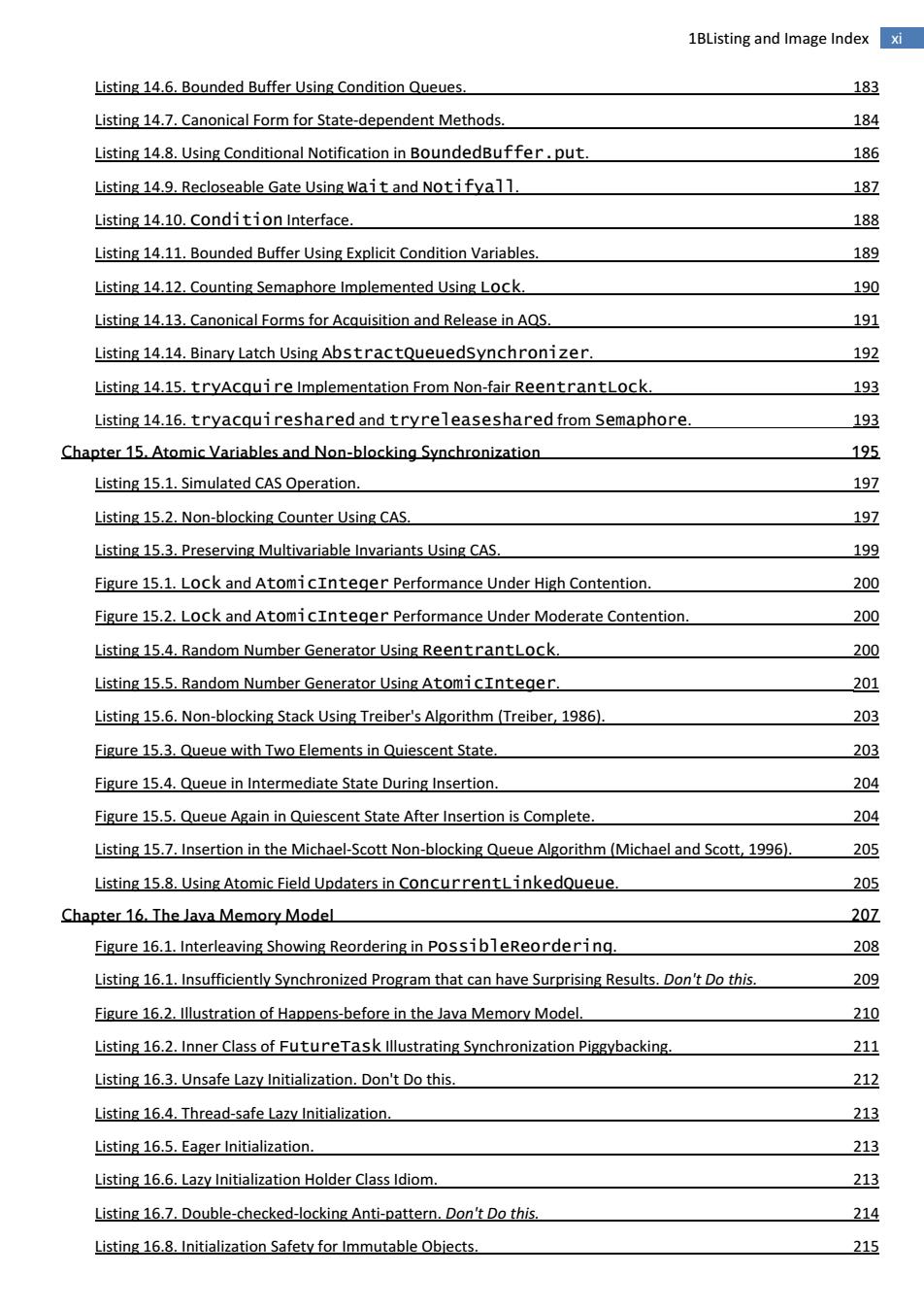正在加载图片...

1BListing and Image Index xi Listing 14.6.Bounded Buffer Using Condition Queues. 183 Listing 14.7.Canonical Form for State-dependent Methods. 184 Listing 14.8.Using Conditional Notification in BoundedBuffer.put. 186 Listing 14.9.Recloseable Gate Using wait and Notifyall 187 Listing 14.10.Condition Interface. 188 Listing 14.11.Bounded Buffer Using Explicit Condition Variables. 189 Listing 14.12.Counting Semaphore Implemented Using Lock. 190 Listing 14.13.Canonical Forms for Acquisition and Release in AQS. 191 Listing 14.14.Binary Latch Using AbstractQueuedsynchronizer. 192 Listing 14.15.tryacquire Implementation From Non-fair ReentrantLock. 193 Listing 14.16.tryacquireshared and tryreleaseshared from Semaphore. 193 Chapter 15.Atomic Variables and Non-blocking Synchronization 195 Listing 15.1.Simulated CAS Operation. 197 Listing 15.2.Non-blocking Counter Using CAS. 197 Listing 15.3.Preserving Multivariable Invariants Using CAS 199 Figure 15.1.Lock and AtomicInteger Performance Under High Contention. 200 Figure 15.2.Lock and AtomicInteger Performance Under Moderate Contention. 200 Listing 15.4.Random Number Generator Using ReentrantLock. 200 Listing 15.5.Random Number Generator Using Atomi cInteger. 201 Listing 15.6.Non-blocking Stack Using Treiber's Algorithm(Treiber,1986). 203 Figure 15.3.Queue with Two Elements in Quiescent State. 203 Figure 15.4.Queue in Intermediate State During Insertion. 204 Figure 15.5.Queue Again in Quiescent State After Insertion is Complete. 204 Listing 15.7.Insertion in the Michael-Scott Non-blocking Queue Algorithm (Michael and Scott,1996). 205 Listing 15.8.Using Atomic Field Updaters in ConcurrentLinkedQueue. 205 Chapter 16.The Jaya Memory Model 20Z Figure 16.1.Interleaving Showing Reordering in PossibleReordering. 208 Listing 16.1.Insufficiently Synchronized Program that can have Surprising Results.Don't Do this. 209 Figure 16.2.Illustration of Happens-before in the Java Memory Model. 210 Listing 16.2.Inner Class of FutureTask Illustrating Synchronization Piggybacking. 211 Listing 16.3.Unsafe Lazy Initialization.Don't Do this. 212 Listing 16.4.Thread-safe Lazy Initialization. 213 Listing 16.5.Eager Initialization. 213 Listing 16.6.Lazy Initialization Holder Class Idiom. 213 Listing 16.7.Double-checked-locking Anti-pattern.Don't Do this. 214 Listing 16.8.Initialization Safety for Immutable Objects. 2151BListing and Image Index xi Listing 14.6. Bounded Buffer Using Condition Queues. 183 Listing 14.7. Canonical Form for StateͲdependent Methods. 184 Listing 14.8. Using Conditional Notification in BoundedBuffer.put. 186 Listing 14.9. Recloseable Gate Using Wait and Notifyall. 187 Listing 14.10. Condition Interface. 188 Listing 14.11. Bounded Buffer Using Explicit Condition Variables. 189 Listing 14.12. Counting Semaphore Implemented Using Lock. 190 Listing 14.13. Canonical Forms for Acquisition and Release in AQS. 191 Listing 14.14. Binary Latch Using AbstractQueuedSynchronizer. 192 Listing 14.15. tryAcquire Implementation From NonͲfair ReentrantLock. 193 Listing 14.16. tryacquireshared and tryreleaseshared from Semaphore. 193 Chapter 15. Atomic Variables and Non-blocking Synchronization 195 Listing 15.1. Simulated CAS Operation. 197 Listing 15.2. NonͲblocking Counter Using CAS. 197 Listing 15.3. Preserving Multivariable Invariants Using CAS. 199 Figure 15.1. Lock and AtomicInteger Performance Under High Contention. 200 Figure 15.2. Lock and AtomicInteger Performance Under Moderate Contention. 200 Listing 15.4. Random Number Generator Using ReentrantLock. 200 Listing 15.5. Random Number Generator Using AtomicInteger. 201 Listing 15.6. NonͲblocking Stack Using Treiber's Algorithm (Treiber, 1986). 203 Figure 15.3. Queue with Two Elements in Quiescent State. 203 Figure 15.4. Queue in Intermediate State During Insertion. 204 Figure 15.5. Queue Again in Quiescent State After Insertion is Complete. 204 Listing 15.7. Insertion in the MichaelͲScott NonͲblocking Queue Algorithm (Michael and Scott, 1996). 205 Listing 15.8. Using Atomic Field Updaters in ConcurrentLinkedQueue. 205 Chapter 16. The Java Memory Model 207 Figure 16.1. Interleaving Showing Reordering in PossibleReordering. 208 Listing 16.1. Insufficiently Synchronized Program that can have Surprising Results. Don't Do this. 209 Figure 16.2. Illustration of HappensͲbefore in the Java Memory Model. 210 Listing 16.2. Inner Class of FutureTask Illustrating Synchronization Piggybacking. 211 Listing 16.3. Unsafe Lazy Initialization. Don't Do this. 212 Listing 16.4. ThreadͲsafe Lazy Initialization. 213 Listing 16.5. Eager Initialization. 213 Listing 16.6. Lazy Initialization Holder Class Idiom. 213 Listing 16.7. DoubleͲcheckedͲlocking AntiͲpattern. Don't Do this. 214 Listing 16.8. Initialization Safety for Immutable Objects. 215